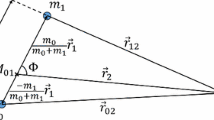Conclusions
Our results show that n = 3/2 and n = 1/2 polytropes are dynamically unstable to non-axisymmetric perturbations if t ≳ 0.30, in rough agreement with linear theory. Instead of fission as the direct end product of dynamic instability in rapidly rotating, centrally condensed stars, it appears that a rapidly rotating star can, through gravitational torques, eject some high angular momentum material in its equatorial plane and settle down into a dynamically stable (lower t) configuration. The central object, at least in the detailed evolution described above, ends up as a stable traixial star! The assumption of reflection symmetry through the rotation axis needs to be relaxed before this evolutionary picture can be considered realistic and before meaningful comparisons can be made with the results of Lucy (1977) and Gingold and Monaghan (1978, 1979), who found “odd” modes to be of crucial importance.
We cannot escape mentioning that the ejected disk/ring of material in our models may have some connection with the formation of planetary systems.
Similar content being viewed by others
References
Bodenheimer, P., and Ostriker, J. P.: 1973, Astrophys. J. 180, p. 159.
Chandrasekhar, S.: 1969, Ellipsoidal Figures of Equilibrium, Yale Univ. Press, New Haven.
Durisen, R. H., and Imamura, J. N.: 1981, Astrophys. J. 243, in press.
Gingold, R. A., and Monaghan, J. J.: 1978, Monthly Notices Roy. Astron. Soc. 184, p. 481.
Gingold, R. A., and Monaghan, J. J.: 1979, Monthly Notices Roy. Astron. Soc. 188, p. 39.
Hunter, C.: 1977, Astrophys. J. 213, p. 497.
Jeans, J. H.: 1919, Problems of Cosmology and Stellar Dynamics, Cambridge Univ. Press, Cambridge.
Lebovitz, N. R.: 1972, Astrophys. J. 175, p. 171.
Lebovitz, N. R.: 1974, Astrophys. J. 190, p. 121.
Lucy, L. B.: 1977, Astron. J. 82, p. 1013.
Lyttleton, R. A.: 1953, The Stability of Rotating Liquid Masses, Cambridge Univ. Press, Cambridge.
Ostriker, J. P., and Bodenheimer, P.: 1973, Astrophys. J. 180, p. 171.
Ostriker, J. P., and Mark, J. W-K: 1968, Astrophys. J. 151, p. 1075.
Ostriker, J. P., and Tassoul, J. L.: 1969, Astrophys. J. 155, p. 987.
Roxburgh, I. W.: 1966, Astrophys. J. 143, p. 111.
Stoeckly, R.: 1965, Astrophys. J. 142, p. 208.
Tohline, J. E.: 1980, Astrophys. J. 235, p. 866.
Author information
Authors and Affiliations
Additional information
This research was supported by National Science Foundation Grant No. AST-7821449.
Rights and permissions
About this article
Cite this article
Durisen, R.H., Tohline, J.E. A numerical study of the fission hypothesis for rotating polytropes. Space Sci Rev 27, 267–273 (1980). https://doi.org/10.1007/BF00168308
Issue Date:
DOI: https://doi.org/10.1007/BF00168308




